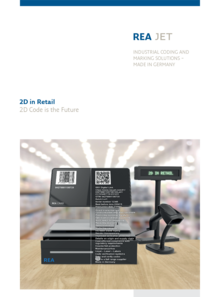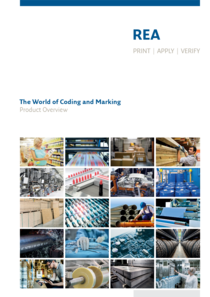codice di cassa 2D con GS1 Digital Link
I codici a barre standardizzati come EAN-13 o UPC-A hanno rivoluzionato la logistica e la vendita al dettaglio. Ora una nuova rivoluzione è all'orizzonte. Le aziende di tutto il mondo stanno modernizzando l'imballaggio e la marcatura del prodotto, migliorando l'intero flusso di informazioni grazie alla stampa di 2D Code.

Finora i codici a barre EAN-13 sono stati utilizzati come codici di cassa nella vendita al dettaglio e nella logistica. Tuttavia, a causa della capacità di dati molto limitata e della crescente connettività, non sono più aggiornati. I produttori sono sempre più chiamati a fornire informazioni sui prodotti in modo semplice e accessibile. Sia per i consumatori che vogliono saperne di più su un particolare prodotto, sia per i grossisti e i dettaglianti che vogliono ottimizzare la loro efficienza accedendo a dati precisi sui prodotti e alle informazioni sulla catena di fornitura.
Una soluzione standardizzata per la marcatura digitale del prodotto sviluppata dall'organizzazione GS1 combina gli standard GS1 esistenti con un nuovo codice universale: il GS1 Digital Link. Con il nuovo standard GS1 Digital Link, gli identificatori GS1, come il GTIN, sono collegati a Internet. Con questo nuovo standard, diverse informazioni su un prodotto possono essere rese disponibili in modo flessibile attraverso un unico link. Ciò significa che le informazioni possono essere personalizzate in qualsiasi momento senza che sia necessario rinnovare il supporto dati, come il QR code, e il suo contenuto.
Gli identificatori GS1 esistenti, come il GTIN, rimangono validi e sono incorporati in un URL conforme agli standard del proprietario del marchio.
Dal 2021, il 2D Code DataMatrix, il QR code con GS1 Digital Link e il DataMatrix code con GS1 Digital Link sono stati approvati come codici di cassa nel punto vendita. La migrazione al GS1 Digital Link può essere effettuata senza grandi modifiche ai sistemi e ai processi esistenti. L'obiettivo è quello di realizzare una migrazione a livello mondiale verso i codici 2D per registratori di cassa entro il 2027.

Il GS1 Digital Link può essere utilizzato con qualsiasi tipo di 2D Code, ma in genere con un QR code. I consumatori possono quindi utilizzare il proprio smartphone per scansionare il QR code sulla confezione del prodotto, che li reindirizza a un sito web definito. A seconda dell'utente, è possibile visualizzare informazioni diverse in lingue e formati diversi. Questo perché concettualmente si tratta dello stesso codice di cassa 2D a cui si accede. Ma app diverse portano gli utenti a destinazioni completamente diverse. Ad esempio, un'app fornisce ai consumatori informazioni estese sul prodotto, come l'origine, gli ingredienti o la data di scadenza (BBD). Con altre app, invece, è possibile promuovere misure di fidelizzazione dei clienti attraverso interazioni con l'app, lotterie o campagne di sconti. E per il produttore, lo stesso codice può fornire informazioni per il controllo dei processi, come la gestione delle scorte, la tracciabilità, la pianificazione della produzione e i richiami mirati.

La struttura
Come si presenta un QR code con GS1 Digital Link?
Per riassumere brevemente: Il GS1 Digital Link mette gli ID GS1 in un formato facile da usare sul web che può essere codificato in un QR code.
In questo esempio, diversi contenuti di dati sono collegati in un GS1 Digital Link e codificati in un QR code. Le informazioni incorporate sono il GTIN 04270001108739, il numero di lotto Lot1, il numero seriale 12345 e la data di scadenza 31.12.2022.

Questo codice 2D è quindi molto più di un semplice codice di cassa 2D nel punto vendita. Oltre al GTIN come codice articolo chiaramente identificabile, i consumatori possono accedere a Internet tramite il proprio smartphone e ottenere informazioni rilevanti, come la data di scadenza, sempre aggiornate e in tempo reale.
La gamma di applicazioni del nuovo GS1 Digital Links è enorme. Può essere utilizzato durante l'intero ciclo di vita del prodotto in tutti i settori di un'azienda. Nell'industria del mobile, ad esempio, i codici 2D Data Matrix (DMC) garantiscono la modernizzazione dell'imballaggio e della marcatura del prodotto.
I casi d'uso e il valore aggiunto includono
- Gestione dell'inventario: mantenimento del FIFO, accuratezza dell'inventario, visione della disponibilità, visione della posizione, evitare gli sprechi, garantire la freschezza
- Tracciabilità: autenticazione dei prodotti, origine degli ingredienti, trasparenza della catena di approvvigionamento, fiducia dei consumatori
- Sicurezza: integrità del marchio, prevenzione della vendita di prodotti scaduti o richiamati, lotta alla contraffazione
- Sostenibilità: informazioni sul riciclo, sull'economia circolare, sulla prevenzione dei rifiuti, dal produttore al consumatore
- Coinvolgimento dei consumatori: accesso a informazioni autorizzate dal marchio, promozioni, ricette, possibilità di interagire con il marchio
- Miglioramento del packaging: obiettivi di marketing on-pack, conformità alle normative, miglioramento dell'esperienza del consumatore
Alcuni settori che utilizzano il nuovo standard GS1 Digital Link sono:
- Industria sanitaria e farmaceutica (standard globale, in parte richiesto dalla legge)
- Settore automobilistico
- Industria alimentare
- Industrie tecniche
- Logistica e imballaggi
- Commercio online
- Industria della moda, dello sport e del tessile
- Industria del mobile

Scoprite le versatili applicazioni delle nostre innovative soluzioni per la marcatura e la codifica, che aiutano a migliorare l'intero flusso di informazioni grazie alla stampa di 2D Code.


Stampanti a getto d'inchiostro ad alta risoluzione, sistemi laser e tecnologia di etichettatura
Quale sistema di marcatura è adatto per la stampa di codici 2D DataMatrix GS1, QR code con GS1 Digital Link e codici DataMatrix con GS1 Digital Link?
Negli ultimi anni la tecnologia CIJ è stata utilizzata in molti settori. Tuttavia, a causa della bassa risoluzione di stampa, la qualità dei caratteri non soddisfa più i requisiti attuali. L'uso di stampanti a getto d'inchiostro per caratteri piccoli per stampare codici 2D in buona qualità e ad alta velocità è adatto solo in misura limitata, particolarmente per i requisiti dei codici 2D per registratori di cassa. Con questa tecnologia non è possibile ottenere elevati tassi di lettura del primo passaggio, particolarmente importanti nel punto vendita.
L'opportunità è quella di sostituire la CIJ con tecnologie TIJ ad alta risoluzione, sistemi laser o sistemi di etichettatura.












